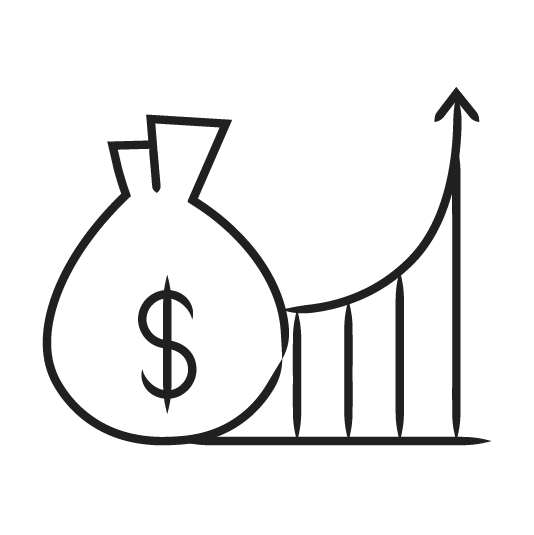Snider Investment Method Performance
Income Focused Results with the Snider Investment Method
We define wealth as the thing that is truly most important to retirees – the ability to support a given standard of living indefinitely into the future.

Two Primary Investment Objectives
Goals of the Snider Investment Method:

Consistent Monthly Cash Flow in Retirement
Our primary goal is to generate monthly income as close to 1% of our total investment as possible.

No permanent loss of capital
In the Snider Method, you will buy fundamentally sound companies you would be willing to own for long periods of time, even if the price declines.
We don’t select stocks because we think we know the future direction of their price, but rather to use them to generate income.
Income comes from:
- Selling options – Covered Calls and Cash-Secured Puts
- Dividend payments from the securities you own
- Interest on the uninvested cash in your account
- Capital gains (or losses) after you sell your securities
- Fees or expenses incurred during the implementation of the strategy reduce your income. The most common cost is trading commissions, which are charged by your broker for the buying and selling of both stocks and options.
Income is reduced by fees and expenses incurred during the implementation of the strategy.
Expenses include:
- Margin interest paid from borrowing from your broker
- Trading commissions cost to place stock and option trades
- Advisory fees for using our AutoPilot or Charter Asset Management services
We define our portfolio performance by the Monthly Net Current Yield. Yield is all realized income – option premiums, gains on sold positions, interest and dividends, net of brokerage commissions and margin interest. It does not include unrealized gains or losses.
The yield calculation is different from the total return calculation typically shown by most in the investment industry. The yield is approximately equal to the total return if and when a position closes. While the position is open, there is typically some amount of unrealized loss. The total return measurement would include these losses and so would be lower than the yield.
Factors Impacting Performance
Type of Account
We have two types of management styles for all our accounts. The style you implement is primarily based on the type of account you open.
Margin
Taxable accounts that can borrow from the broker utilize our slightly more aggressive margin formula.
Non-Margin
Retirement type accounts use our non-margin formula since they can’t borrow from the broker. Our non-margin approach is more conservative and will likely experience slightly lower yields.
Due to the tax-advantaged nature of retirement type accounts, the after-tax return of both approaches is very similar.
Size of Account
You can implement the Snider Investment Method on portfolios from $25,000 to many millions of dollars. We don’t recommend anyone use the Method on an account below $25,000. For accounts with just one position, we advise clients utilize an exchange-traded fund (ETF) rather than an individual stock to reduce company specific equity risk.
Our experience shows larger accounts (greater than $200,000) can achieve more consistent Net Current Yields from month-to-month. Greater consistency is mainly due to holding more Snider Method positions and greater diversification. At $500,000, we start to optimize the allocation to improve income generation. This should allow these account to earn more income over time.
Economic Market Conditions
Outside Factors Impacting Performance
Factors outside our control also impact your performance. These factors can positively and negatively affect performance. The Snider Investment Method is designed to perform well in a wide range of conditions. The range includes the conditions investors most often experience while investing in the stock market. There can be extremes on both ends that limit the effectiveness of our strategy as well as other investments.
In the Method, we do not try to predict the next bull or bear market. Instead, we perform a consistent strategy that has worked in a wide range of markets. The biggest factors include:
Bull Markets
Extremely good market conditions may cause the Method to not perform as well as other stock market investments. This is due to the nature of two critical tools in the Snider Investment Method approach.
With our covered call approach, we collect a premium each month in exchange for allowing another investor to buy our shares at a higher price. The strike price of our option caps our upside. When stock prices increase dramatically before expiration, we only capture a portion of that appreciation and our premium. Since this is somewhat unusual, we accept this tradeoff.
All portfolios generally consist of a percentage of equities (stocks) and cash. In good market conditions, the cash portion of your account does not appreciate in value. Our non-margin accounts tend to carry a larger percentage of cash and are more greatly impacted in strong bull markets.
Bear Markets
The Snider Investment Method’s biggest test came in the financial crisis of 2008 & 2009. With market declines exceeding 50%, we experienced the most significant bear market since the Great Depression. The steep reduction in stock prices limited our ability to produce the same income as our historical levels.
The rules of the Snider Investment Method prohibit selling stocks at a loss, but this does not limit or prevent the accumulation of unrealized losses which are not included in the yield calculation. These unrealized losses could persist indefinitely, and our performance may never reflect them.
You can lose money by terminating a position before it closes because at any time the unrealized losses can be higher than the total yield of a position over its lifetime. Bear markets will create a greater amount of unrealized losses and increase the highest risk to the Snider Investment Method, bankruptcy.
When a company declares bankruptcy, we realize the entire loss from the position in the month it is announced. Although our goal is to screen out financially unstable companies, the screens are not foolproof. Accounts experience a permanent loss of capital invested when a company within the account files for bankruptcy.
Volatility
Stock market volatility is when prices go up, down, up, down, etc. The more considerable those swings, the greater the volatility. This is a bigger factor for the Snider Method than other investment strategies because of the use of options. Higher volatility will mean greater option income for call and put sellers. The market can experience extended periods of both high or low volatility.
Interest Rates
Since a portion of your portfolio can be in cash, interest rates play an important role in our monthly income. After the Great Recession in 2008-2009, interest rates dropped to 0% for the first time in US history. It stayed at very low levels for many years. This meant a portion of the portfolio was earning no income. Currently, these rates are on the rise, and our cash is back to being paid a monthly rate.
Managing Stock Market Risk
Cash vs. Equity Allocation
Our biggest way to manage risk between bull and bear markets is changes in our cash balance. Our goal is to have more cash (and less investment) at market peaks and more investments (and less cash) at market bottoms.
This creates a natural buy low and sell high process. It also reduces our equity exposure at the start of the bear market to mitigate the impact of a significant market decline.
Unique Results
One aspect that makes the performance of the Snider Investment Method different from other investment strategies is that no two accounts may be exactly alike. Each account and client portfolio is managed uniquely based on their specific requirements. While many clients may hold the same stock, it is very unlikely they have the same entire portfolio as another client. As a result, each client experiences unique results. On average, we expect our clients to obtain similar results, but anyone can and will experience periods of both above-average and below-average income.
We’ve been managing portfolios and tracking their Monthly Net Current Yield since our company’s inception in 2002. Over that time, our managed margin (taxable) accounts have been able to achieve results very close to our stated goal before any management fees. Our more conservative non-margin (tax-deferred) approach produced slightly less monthly income over the same period.
We are very proud of our performance and historical track record. Unfortunately, due to the uniqueness of the investment strategy and the individual management of each account, it has become intensely complicated to calculate and publish performance figures along with all the necessary regulatory requirements, disclosures, and explanations. Currently, we are working to overcome these hurdles and provide easily understood and current performance figures.
More Covered Call and Option Trading Education
We pride ourselves on empowering both beginner and experienced investors. As covered call advisors, we use our extensive knowledge to train our clients to write covered calls and boost the income from their portfolios.

